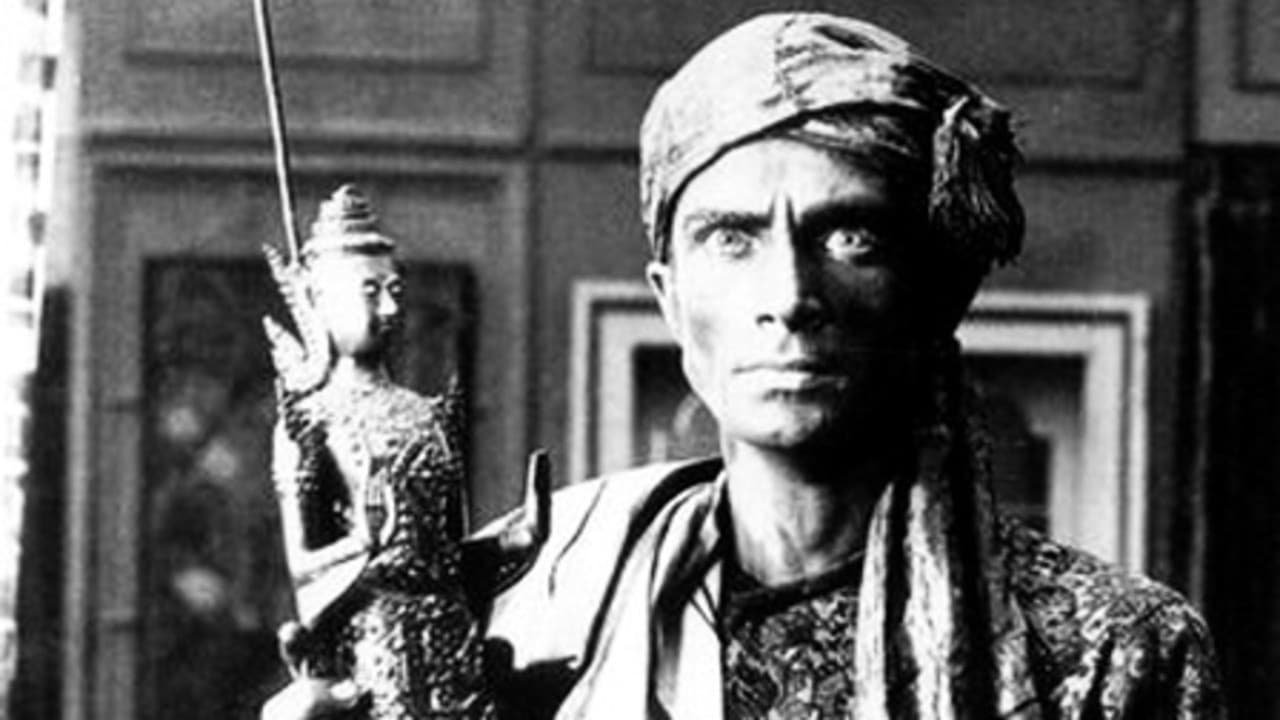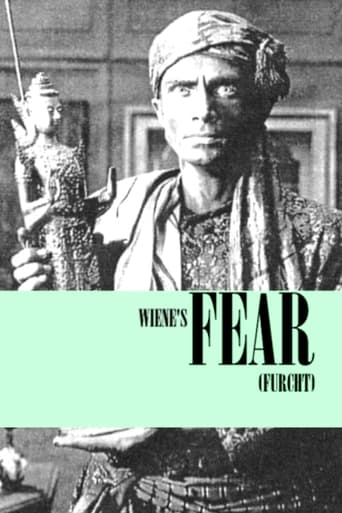

Though the German Expressionist movement in cinema officially began with THE CABINET OF DR. CALIGARI (1919; coincidentally from the same director as the film under review), the country's first brush with the horror genre occurred in 1913 via THE STUDENT OF PRAGUE (subsequently much-remade). The movies in this vein that emerged in between these two titles are not easily come by, so it was interesting to catch this obscure effort (which lasts for only 54 minutes!). Actually, FEAR is now the fourth Wiene I have checked out after CALIGARI itself, RASKOLNIKOV aka CRIME AND PUNISHMENT (1923; as it happens, an American potboiler from 1946 based on the same Dostoyevsky source shared its title with the film under review!), and the 1924 version of THE HANDS OF ORLAC. For the record, I am also familiar with the compressed surviving version of the director's GENUINE: THE TALE OF A VAMPIRE (1920) and own but have yet to watch his DER ROSENKAVALIER (1925).Anyway, the film's plot deals with a man haunted by a misdeed he has committed (his obsessive passion for rare objets d'art has driven him to make away with a statue from an Indian temple). In fact, the plot opens with the hero's arrival at his estate from abroad where he is already in an agitated state and orders his myriad servants to bar the entrances and exits! One of them, however, is worried by his master's paranoia and seeks advice from the town minister and the hero's former schoolteacher, who instantly realizes that what he needs is not a man of God but of Science! Soon after, he is visited by a mysterious man in Indian garb (a brief role for Conrad Veidt, later co-star of CALIGARI and protagonist of ORLAC) who prophesies that, in seven years' time, the man will meet his come-uppance by the hand of the one whom he loves most!Somewhat relieved, the hero decides to live up the time allotted to him and begins to lead a hedonistic lifestyle which, however, he soon tires of, so he picks up medicine and apparently comes up with some astonishing discovery but which he promptly destroys at its much-publicized unveiling! So, as he often says, "on to something new" and, now, he falls in love and plans to marry but, since the 'contract' is about to expire, he soon grows morose and alienates his intended! At the appointed time, even if he had disposed of the statue in a river in a desperate attempt to break the spell (should he not have contrived to return it to the rightful owners if any hope of clemency was to be expected?), he is so nerve-wracked that he shoots himself suggesting that he had loved himself best of all! Soon after, Veidt reappears and picks up the statue not from the river-bed but rather from where the hero used to keep it, to which cabinet it had magically returned!While the film's visuals are nowhere near as striking as Wiene's subsequent forays into outright Expressionism, the exaggerated acting style is evocative of them, since the protagonist shares the mental strain that affects the heroes of CALIGARI, RASKOLNIKOV and ORLAC – which can now be identified as something of a pattern within his work!; in the end, this is no lost classic but worth viewing nonetheless.
... View MoreI have no doubt that Conrad Veidt would have been phenomenal in this movie...had he actually had a substantial role in it. Granted, the version I viewed had been edited down to 60 minutes from the original 72 (and some of Connie's scenes may have been edited out). But out of the 60 min. I saw, barely over 2 minutes are devoted to Conrad's character. Needless to say, fans of Conrad Veidt will find this film a bit of a disappointment.Fans of overwrought melodrama, however, can hardly find a better example than Bruno DeCarli's chest-clutching, flopping about the room in a paranoiac spasm, back-of-the-hand-to-the-forehead seizures...a perfect example of criticisms often aimed at silent film "overacting." This is not an unentertaining film, but it has more of a novelty value than an artistic one.Since I collect Conrad Veidt films, I can honestly say that there are many more fine examples of his acting finesse than this one, including most of his talkies. In fact, a large part of what makes his films so compelling is his rich and expressive voice. He had few equals in his ability to convey a natural elegance and maturity in his roles.In seeking to experience the full gamut of Connie's ability,"Furcht" has little to offer. Better examples of his talent and versatility may be found in "Jew Suss", "The Passing of the Third Floor Back", "The Spy In Black", and "The Last Performance", among others.
... View MoreI saw 'Furcht' in July 1996 at the Cinema Ritrovato festival in Bologna. They screened a print with the original German intertitles, loaned by the Deutsches Institut für Filmkunde.One of my all-time favourite films is 'The Cabinet of Dr Caligari', which is by far the most famous movie directed by Robert Wiene. However, that film was in pre-production with Fritz Lang intended as the director; Wiene stepped in only at the last moment, and much of the movie's appeal is due to the remarkable production design (by Hermann Warm) or other factors for which Wiene cannot take credit. 'Furcht' is a more accurate representation of Wiene's directorial talents: it's not nearly so good as 'Caligari' (few films are!), but Wiene proves himself able to create an eerie dream-like mood which suits this story admirably. Whereas the events in 'Caligari' are clearly a madman's nightmare, the nightmarish story of 'Furcht' seems to be more firmly rooted in reality and sanity, and only gradually do we begin to feel that the events on the screen may be the protagonist's nightmare rather than his reality ... or perhaps they are both, in which case he has no escape.Bruno Decarli plays a European aristocrat in Java. He takes a fancy to a weird-looking statue of a local pagan god, which is protected by an even weirder-looking priest (played by Conrad Veidt, who is apparently portraying a Hindu). Decarli decides to steal the statue; in order to achieve this, he murders the priest. However, the priest's ghost haunts Decarli, warning him that he will die in seven days' time...Conrad Veidt was one of the best actors in silent films. He seemed rather less successful in talkies, possibly down to having aged a few years and lost the knife-edge of his virility. In 'Furcht', Veidt is astonishingly thin and absolutely compelling as a wraith. I've seen hundreds of actors portray ghosts, but Veidt's performance here is one of the very few which convinced me that the character was actually speaking from the realm of the dead. Veidt's gaunt appearance and his expressive hands skilfully convey the incessant hunger of the dead and their resentment of the living. I'll rate this movie 9 out of 10, and I wish that Weine's films came up to this standard more often.
... View More